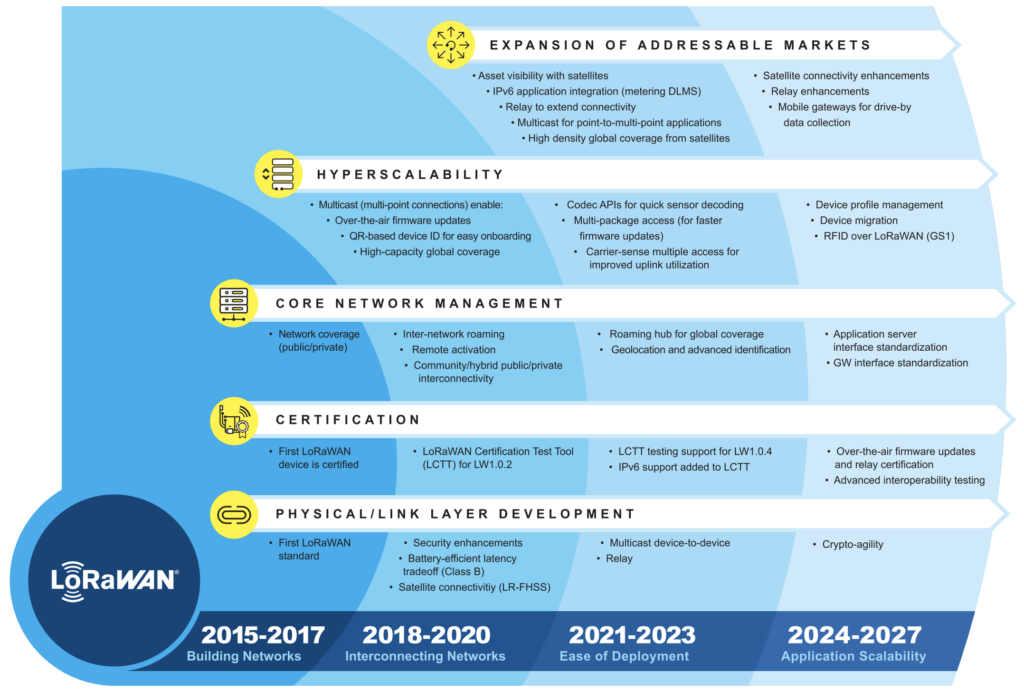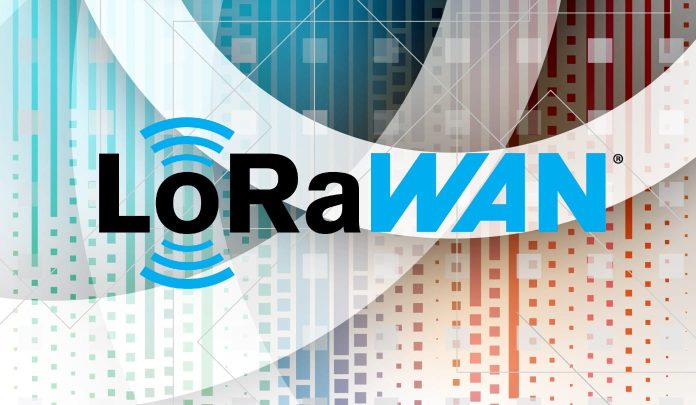The LoRa Alliance, the association of companies steering the open LoRaWAN standard, has released a formal development roadmap to enhance features, simplify deployments, drive interoperability, and raise security. The objective, invariably, is to multiply LoRaWAN deployments in new and existing enterprise IoT segments. The work puts a major focus on non-terrestrial network (NTN; satellite) connectivity and simpler device management, including with over-the-air updates and relay certification. There is also a focus on ‘crypto-agility” and RFID over LoRaWAN.
The work splits broadly into five loose categories across four overlapping phases, which have informed the alliance’s work and guided its focus for a decade already: from building networks in the 2015-2017 period, through connecting them in the 2018-2020 period, to making deployments on LoRaWAN networks easier during 2021-2023 and, now, making applications more easily scalable, in the period to 2027. The work streams have continued through the years, but the initial phases focused on the physical / link layer, certifications, and core network management.
More recently, the development work has expanded to include hyper-scalability, and also core tech enhancements crossover hybrid mashups in order to expand addressable markets. The LoRa Alliance has issued a schematic (see below) to plot its development work, and explain its logic. New markets will be addressed mainly with further LoRaWAN expansion of initial NTN capabilities, through, for example, further optimization of the long range–frequency hopping spread spectrum (LR-FHSS).

New relay enhancements will increase signal reach in noisy or physically challenging environments, to allow LoRaWAN sensors to be placed more widely; there is also a schedule of 2024-2027 works to add “fast and low-power network discovery… where coverage is not permanent, like mobile gateways”. A statement talks about allowing “walk-by or drive-by applications”, where network coverage is unavailable for remote readings / updates. The alliance said this will provide “significant value” for markets like utilities, where LoRaWAN has a foothold.
Work to enable “hyper-scalability”, started ostensibly in 2021, will see the standard bearers in the ecosystem simplify deployments with easier profile management and device migration, and also enable GS1-compliant identifiers – such as RFIDs, barcodes, electronic product codes (EPC) – over LoRaWAN to enable LoRaWAN-based IoT devices to be used for product/asset identification. There is also work scheduled to automate device onboarding by requesting device profiles from online repositories using a standard API; this will build on previous work around QR codes.
There is other work planned to strengthen device interoperability by standardising application server and gateway interfaces, and to add over-the-air and relay updates for certification testing, plus advanced interoperability testing in the LoRaWAN certification test suite. The alliance wants to introduce so-called ‘crypto-agility’ to the physical / link layer, too, so current and future “crypto-suites” can be used as add-ons without having to take a hammer to the original link layer.
The alliance claims LoRaWAN has the “most low-power wide-area network (LPWAN) deployments globally across terrestrial and non-terrestrial networks”. There is no explanation of how it is counting this. It also claimed a “market-leading position” in smart metering, without splitting-out metering disciplines. It also flagged work by LoRaWAN operator ZENNER Network – with “nearly 7.5 million sensors on more than 100,000 gateways in 15 countries”, supporting the energy and utilities, smart cities, and industrial IoT markets.
In bombastic fashion, Donna Moore, chief executive and chairwoman at the LoRa Alliance, declared: “Not only is our technology best-of-breed and proven across multiple multimillion-sensor deployments, but it is also backed by the largest ecosystem with the greatest number and diversity of certified devices. Further, it offers the widest variety of deployment options across terrestrial networks and satellite NTNs… As such, it is the only LPWAN that can address the requirements of any organisation looking to deploy large-scale, low-power IoT solutions today.”

